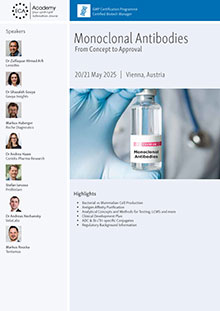QUALITY BY DESIGN - AN INTERDISCIPLINARY SYSTEM FROM DEVELOPMENT TO REGISTRATION AND PRODUCTION
What exactly is Quality by Design? This is a question often raised in the pharmaceutical industry these days. The latest developments in implementing this concept and practical examples were discussed at ECA's 2nd Good Development Practice Conference in Berlin (22-24 April 2008).
Overall, Quality by Design (QbD) has to be seen as an overarching paradigm with PAT, Design Space and a sophisticated control strategy as its most important tools. It is important to notice that QbD does not only focus on the development phase of a product or its production as a marketed product. It has to be seen as an interdisciplinary system from development to production - as a systematic approach emphasising enhanced product and process understanding. Ideally, QbD already starts in the early design phase of a drug product where both patient needs and process design should be kept in mind. During the ongoing design of process and product, it is important to determine critical quality attributes and to understand how process parameters affect these attributes.
It was pointed out during the conference that QbD is more than simple Design of Experiments (DoE) and a respective process optimisation. It rather reflects the full understanding of how critical process parameters relate to critical quality attributes and how continuous monitoring and control can enhance process performance and product quality. Only then safety and efficacy can be granted for all batches - which is the final goal.
The possible advantages for the pharmaceutical industry are obvious:
- Consistent high product quality through better process understanding and control
- Right-first-time of all batches produced
- Implementation of real-time release
- Risk mitigation
- Easier knowledge management and transfer
Professor Gert Ragnarsson from the Swedish Medical Products Agency emphasised the possible win-win option for both industry and regulating authority towards "more flexible, risk-based, regulatory decisions".
Successfully implemented, a high level Quality by Design programme can reduce manufacturing costs and improve competitiveness. For patients, high quality drugs mean safe and effective drugs which might also be available earlier because of shorter time to approval.

Recommendation
27/28 May 2025
How to write the Quality Part of an IMPD - Live Online Training
One important document in establishing a QbD concept is ICH Q8 on Pharmaceutical Development. The key concept introduced by ICH Q8 is to design and develop a high quality product and a respective manufacturing process. As also discussed during the conference, critical attributes and parameters should be identified, monitored and controlled. And that applies not only to the process but also to excipients and the formulation. These should be assessed to the extend a possible variation could have an impact on quality and efficacy - leading the way to an effective Design Space.
During the whole development phase, the critical attributes and parameters should be identified as early as possible to limit the number of necessary experiments. This can be done with a risk analysis (e.g. FMEA) and/or based on experience. The necessary process information can be gained from carefully planned development studies, changes during development, deviations and other unexpected results. Failed batches and OOS-results should be thoroughly reviewed as they can give valuable information. A systematic approach facilitates continuous development and innovation.
The definition of ranges for the critical parameters marks the next step. To define the Design Space, "Edge of Failure", "Proven Acceptable Ranges" and "Normal Operating Ranges" should be specified. And it is very important to document everything; not only GMP-relevant data.
But how can the information be efficiently integrated into CMC documentation?
The following key aspects should be discussed in the 3.2.P.2 Pharmaceutical Development section of a regulatory submission in the ICH M4 CTD format:
- Rational for product and dosage form
- Key product characteristics incl. release profile
- Choice of excipients (excipient characteristics)
- Choice of formulation and manufacturing process
- Critical parameters with limits and how they are controlled
Besides P2, there are other places where QbD and Design Space concepts should be discussed. For example:
- S2.3 (Justification for Starting Material Designation)
- S2.4 Justification of Controls and Critical Steps
- S2.6 Development of the Synthesis
- P3.3 Manufacturing Process and Process Controls
- P3.4 Controls of Critical Steps and Intermediates
- P5.6 Justification of the Specification
Conclusion
Dr Thorsten Herkert from the former AstraZeneca Site in Plankstadt, Germany, expressed his point of view as follows: Pharmaceutical Development should transform from

Recommendation
Heidelberg, Germany18-20 November 2025
GMP meets Development
- "reactive to preventive"
- "rigid cGMP to risk-based"
- "black-box to science-based processing"
- "post-process to real-time verification and release"
- "empirical control to predictive output"
Author:
Wolfgang Schmitt
CONCEPT HEIDELBERG



